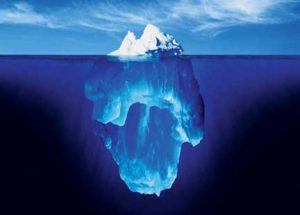Culture is not like an iceberg
By Milton J. Bennett
 With all due respect to theoreticians who continue to use the iceberg metaphor to describe culture, I think it’s time to retire the image altogether. Here’s why.
With all due respect to theoreticians who continue to use the iceberg metaphor to describe culture, I think it’s time to retire the image altogether. Here’s why.
Most people with any background in intercultural communication theory agree that culture is not a “thing”; it is the process whereby groups of people coordinate meaning and action, yielding both institutional artifacts and patterns of behavior. We feel it is unfair when anthropologists and critical theorists accuse us of essentializing culture. But many interculturalists actually do essentialize culture by using the objective metaphor of an iceberg.
Comparing culture to an iceberg floating in the sea implies that culture is an actual thing. The 10% above the water is really visible to everyone who looks in that direction, and the 90% below the water is both real and dangerous, since it can sink the unwary sojourner.
The metaphor does not in any way imply that culture is a process of coordinating meaning and action – rather, it implies that culture is an entity with mysterious unknown qualities. So, while we ourselves may not romanticize or exotify foreign cultures, we inadvertently support those who do by teaching this metaphor.
This situation is a great example of paradigmatic confusion. We want our students or clients to engage culture in a dynamic way, enabling them to understand complex cultural identity formation and generate mindful intercultural communication.
These are laudable goals drawn from a constructivist paradigm. But then we introduce the topic with a distinctly positivist metaphor – the iceberg. The client is left with a simplistic understanding of culture that cannot support the complex operations vis a vis culture that we subsequently advocate.
In other words, we are shooting ourselves in the foot with this metaphor. Let’s find a more appropriate one.
For many years I described culture metaphorically as a river that both carved and was constrained by its banks. While this gets at the “co-ontological” construction of boundary conditions, it doesn’t really capture the coordination of meaning idea.
The seemingly related idea of a river (e.g. the Amazon) with tributaries flowing into it strikes me as being another paradigmatically confused metaphor, since it implies that cultural diversity (relativism) disappears into a transcendent unity (positivism). Other ideas?

7 Comments
Join the discussion and tell us your opinion.
I think the model has value a construct to help learners appreciate the importance of cultural inputs in achieving organizational effectiveness. I also think that in the hands of appropriate individuals (but not all leaders), this concept can serve as an actual formula to develop organizational effectiveness.
The idea is to avoid the reification (essentializing) of culture with this kind of metaphor. When we treat culture as if it is a thing, it is easy to fall into stereotypes and “do’s and don’ts.” You can do better!
[…] a 2013 blogpost, Milton J. Bennett, a leading figure in the intercultural communication field, proposed to abandon […]
I appreciate the thinking and challenging of the Iceberg that I have used with the Circle of Diversity method to teach unconscious bias. The benefit of and iceberg as I see it to people first learning about culture is that it can evoke humility and recognition of the complexity of culture. I combined this with the four Circles of Diversity exercise with personality in the center and visible and invisible aspect of cultural identity in each ring. I challenged learners to toggle between these and then engage with each other as complex participators in culture by talking about their own salient identity by choosing 7 identifiers.
The iceberg formula did help me as far as seeing below the surface. There are so many things that
contribute to culture and who we are besides where we were born or our nationality. The formula made
me look deeper than just a shallow view of what somebody was like .
The iceberg functions as an introduction to the idea of culture for those new to the discussion. It is a simplistic model because it needs to be easy to access. Imagine you were teaching kindergarten science, you might not begin your first lesson with quantum entanglement theory – it is too complex. Lessons are scaffolded through age-appropriate lessons until students might have the skills and understanding to tackle more complex concepts. This iceberg is no different. It is the first stepping stone to thinking outside of our own culture.
Thanks for your comment! Allthough it may not have been completely clear in this short article, the problem with the iceberg metaphor is not that it is insufficeintly complex; it is that it is based on the wrong paradigm. To use your science parallel of preparing for teaching quantum entanglement, it would be like first teaching the Dalton model of the atom, which is certainly siimple, but not paradigmatically compatiible wiith quantum theory.